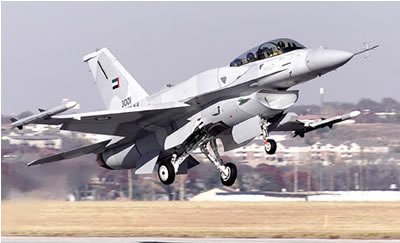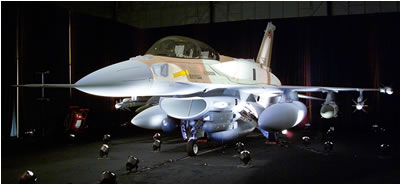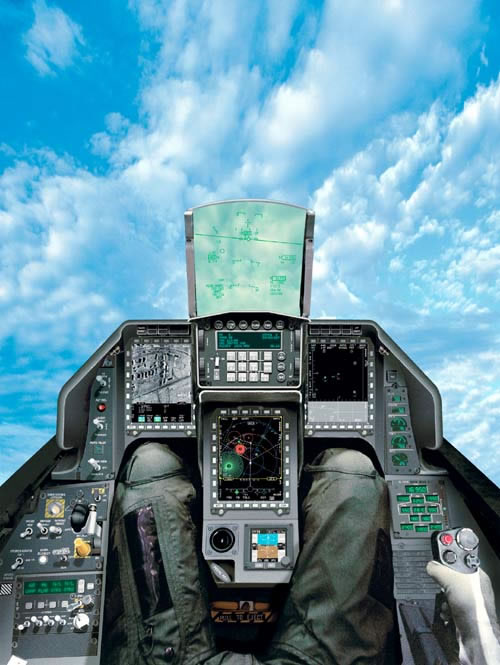
Lockheed Martin’s F-16 was known as “the workhorse of Desert Storm” and its combat-proven tradition continued in Operation Iraqi Freedom in 2003, with close to 4,000 sorties flown in continuous, all-weather operations. The production lines of this versatile strike fighter revived since the turn of the century, with new production orders for 344 aircraft and modernization and upgrading contracts for many more, that position this air combat veteran at the leading edge of air warfare. Firm orders will provide production line work until at least 2008, with anticipated new orders and deliveries lasting through 2011.

The latest Fighting Falcons rolling off the Lockheed Martin’s production line in Fort Worth, Texas, are advanced Block 50/52 and lately, Block 60 versions. These production series represent the largest configuration change in the F-16 history, offering additional fuel and payload capacity, new or improved avionics and sensors, color cockpit displays with enhanced pilot/vehicle interfaces. Nine countries have already ordered Advanced Block 50/52/60 F-16s, including the USA, Greece, Israel, UAE, Chile and Poland, The lead customer for Block 52 was the Hellenic Air Force which will receive all its 50 new F-16s in 2004. 30 additional aircraft, plus options for 10 were ordered by the Greek government In December 2005, with deliveries scheduled for 2009. The Israeli Air Force will receive its first F-16Is in February 2004 and the last of the 102 aircraft is scheduled for delivery by 2008. The lead customer for 80 Block 60 aircraft was the Air Force of the United Arab Emirates which is also in production for initial deliveries in 2004.

Advanced versions of the Block 50/52 F-16s are difficult to tell from previous F-16s, as most changes are internal. However, the two-seat models of the Advanced Block 50/52 and Block 60 are equipped with a dorsal avionics compartment that accommodates all of the systems of the single-seat model as well as some special mission equipment and additional chaff/flare dispensers. Most aircraft are procured wit Conformal Fuel Tanks (CFT) for extended range and mission endurance. The rear cockpit can be configured for either a weapon system operator or an instructor pilot and can be converted with a single switch in the cockpit.

Advanced Engines
Advanced Block 50/52 aircraft have a common engine bay that allows customers a choice of engines in the 29,000-pound thrust class. The Block 50s and are powered by the General Electric F110-GE-129 and have the Modular Common Inlet Duct (known as the large mouth inlet). Block 60 aircraft (for the UAE) are fitted with GE F-110-GE-132 engine, a derivative of the F-110-GE-129 that is rated at 32,500 pounds of thrust. The Block 52s are powered by the Pratt & Whitney F100-PW-229 Improved performance Engine (IPE) which also has 29,000 pounds of thrust. The engine is configured with the Normal Shock Inlet (also known as the small mouth inlet). The aircraft is also equipped with an on-board oxygen-generating system replaces the liquid oxygen system of earlier versions to provide breathable air to the pilot. The system improves mission rate, maintainability, deployment flexibility and safety.
Targeting and Weapon Systems
For air/air missions, the aircraft is equipped with medium range missiles such as the AIM-120A AMRAAM. For close range combat, the aircraft can support the AIM-9X, IRIS-T, Python 4 and Python 5. The aircraft also retains the capability to use the six barrel 20mm Gatling gun. Block 52 configurations are also equipped with an advanced version of the APG-68 radar – the (V)9, while F-16E/F is fitted with the new APG-80 Active Electronic Scanning Array (AESA) system. These new radars have improved performance, higher processing speed and memory capacities and improved high-resolution synthetic aperture radar mode which allows the pilot to locate and recognize tactical ground targets from considerable distances. In conjunction with inertial aided weapons, the advanced F-16 gains an enhanced capability for all-weather precision strike from standoff distances. Modern F-16s of the advanced Block 50/52 can accommodate various targeting systems, including the Lockheed Martin Sniper XR/Pantera, and Northrop Grumman/RAFAEL Litening. These pods are used for target identification, acquisition and designation for smart, GPS guided munitions or laser guided bombs such as GBU-31 Joint Direct Attack Munition (JDAM), the AGM-154 Joint Standoff Weapon (JSOW), SPICE guided weapon, and CBU-103/104/105 Wind Corrected Munitions Dispenser (WCMD). The later can also be cued by target data provided directly from the radar, in low visibility conditions. On recce missions, advanced F-16s can also carry autonomous reconnaissance pods on the centerline, on intelligence gathering penetration or standoff sorties.
Navigation Systems
A navigation pod, such as LANTIRN/Pathfinder and digital terrain models are contributing to a safe, accurate low level flight. The aircraft is also equipped with various navigation systems such as tactical air navigation (TACAN), VHF omnidirectional receiver (VOR), distance measuring equipment (DME), and instrument landing system. An integrated precision navigation suite consisting of a ring laser gyro inertial navigation system (INS), global positioning system (GPS), and digital terrain system (DTS) are also standard.
Cockpit Configurations
 The standard configuration of an Advanced Block 50/52 cockpit features helmet-mounted cueing system, which allows the pilot to direct sensors or weapons to his line of sight or to help him find a designated target. Head-Up Display and several color multifunction displays and advanced recording and data-transfer equipment is used to reduce pilot workload in every phase of the mission. The cockpit is compatible with night vision goggles. A common configuration includes multi-channel VHF/UHF/HF/Data communications, satellite communication and tactical data link systems (such as the NATO-standard Link 16), in addition. Link 16 provides secure, jam-resistant, high-volume data exchange on a multi-node network. Also standard is the combined friend from foe interrogator/ transponder, which permits autonomous identification to maximize launch ranges of radar-guided air-to-air missiles at distances beyond visual range (BVR).
The standard configuration of an Advanced Block 50/52 cockpit features helmet-mounted cueing system, which allows the pilot to direct sensors or weapons to his line of sight or to help him find a designated target. Head-Up Display and several color multifunction displays and advanced recording and data-transfer equipment is used to reduce pilot workload in every phase of the mission. The cockpit is compatible with night vision goggles. A common configuration includes multi-channel VHF/UHF/HF/Data communications, satellite communication and tactical data link systems (such as the NATO-standard Link 16), in addition. Link 16 provides secure, jam-resistant, high-volume data exchange on a multi-node network. Also standard is the combined friend from foe interrogator/ transponder, which permits autonomous identification to maximize launch ranges of radar-guided air-to-air missiles at distances beyond visual range (BVR).
Additional Parts of this article :
- Advanced F-16 Block 50/52/60
- Modernization of the F-16 Fleet
- F-16 Software Upgrade





















